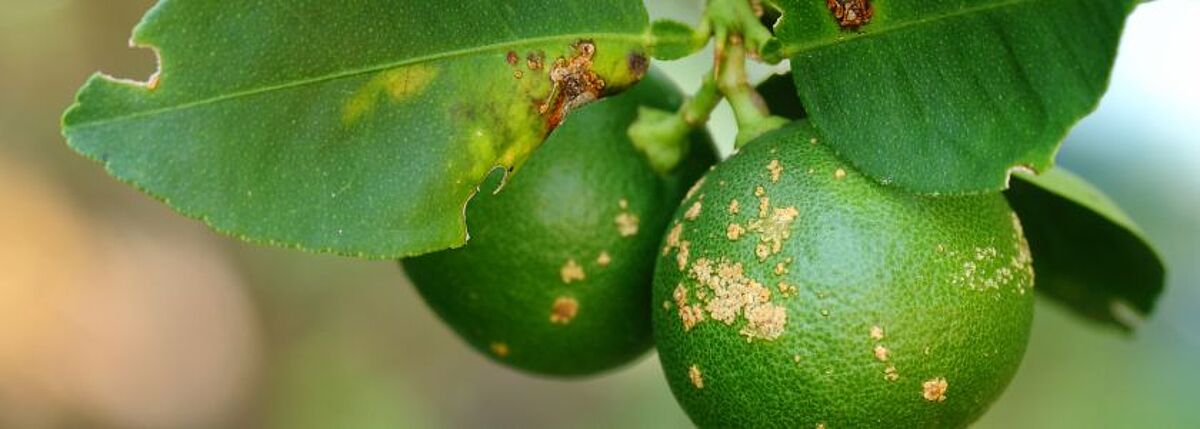
The takeaway: Thanks to CRISPR technology, the agriculture world now has an efficient way to create a citrus tree that can resist a destructive canker disease. Read to see how IDT researchers and products contributed to this finding.
Fruit trees might live in dreamy tropical or warm winter desert settings, but there’s a lot at work in the natural world trying to ruin their day. Moths, mildew, rot, blight, rust, maggots, and more can stunt growth, prevent flowering, turn pretty fruits ugly, and even kill trees. Among the most meddlesome is citrus canker, which can not only cause leaves and fruit to drop prematurely but make the fruit that can be harvested look like it was hit with an ugly stick. No cure exists for citrus canker, but a team of researchers using IDT products recently came up with a way to combat the disease using CRISPR.
What is citrus canker?
Citrus canker is a disease that affects citrus plants and trees. Caused by the bacterium Xanthomonas citri, citrus canker leads to lesions on stems, fruit, and leaves; the lesions are generally brown and raised. While ugly for sure, the presence of the bacterium is not harmful to humans. It is, however, harmful to the plants and fruit, making the fruit difficult to sell and causing plants to shed leaves and fruit prematurely.
Citrus canker is most commonly found in traditional fruit growing areas, and in the U.S. is mainly found in Florida. Internationally, it is found in warm, wet areas such as Brazil, Paraguay, India, Mexico, and Thailand.
History of citrus canker
Citrus canker is thought to have originated in southeast Asia. Citrus canker was first identified in Florida in the early 1900s and quickly spread throughout the state and beyond. That outbreak took more than two decades to get under control, with millions spent on the effort and entire groves levelled. It appeared again in Florida in 1986 and one more time in the mid-1990s.
Citrus canker disease cycle
Xanthomonas citri enters citrus leaves stomata or finds its way into the plant through wounds caused by weather or insects. The bacteria does the most harm to young leaves, though mature leaves are susceptible, too. Symptoms usually appear within two weeks of exposure, and bacteria can hang around on plant surfaces for months, with the bacteria spreading to other plants by wind and precipitation, or through human means, such as moving exposed tools, leavers, branches, clippings, and fruit itself.
New outbreaks of citrus canker most commonly occur when new shoots emerge or when the fruit begins to develop.
What fruit species are most commonly impacted by citrus canker?
The most highly susceptible species are key lime, kaffir lime, lemon, and grapefruit, while those seen as generally susceptible include varieties of limes, oranges, tangerines, and tangeloes. Citron, mandarins, and kumquats are resistant to highly resistant.
Citrus canker control and management
Until now, citrus canker control and management have been fairly rudimentary: There are quarantine measures in place for many areas where the canker is not present or has been eradicated, while integrated management tactics are used in areas where the canker is present or likely to occur. Resistant cultivars are used, while exclusion, eradication, and sanitation are also employed. Eradication is most commonly used—and also the most impactful to farming operations. In Florida, one eradication policy involved removing all citrus trees within 1,900 feet, or more than half a kilometer, of a tree discovered to be infected with canker. This eradication involves cutting the trees down and burning them or chipping them and then hauling the chips off to a landfill.
Can CRISPR offer a better solution to citrus canker?
What if the citrus industry could grow a canker-resistant citrus tree—and do it quickly?
The development of disease-resistant plants is a well-established though time-consuming process. Genetic engineering is a powerful tool for creating resistant crops or enhancing resistant crops. Conventional breeding methods have also been used for ages, though this is a lengthy and labor-intensive process.
Original genetic engineering efforts used transgenic methods, where DNA from unrelated organisms is artificially introduced into a target species. Genes that encode a desired trait—anything from food color to drought resistance—are introduced into the genome at different locations as the plant develops. This process, however, is being transformed by CRISPR genome editing.
In plants, gene editing permits modifications such as deletions, insertions, and DNA replacements into plant DNA, and these modifications can take place at specific designated targets. For example, using CRISPR/Cas-mediated genome editing to create citrus resistance to Xanthomonas citri.
Writing in Nature, a team of researchers, which included an IDT research scientist, created a transgene-free canker-resistant C. sinensis cv. Hamlin—a popular orange—using LbCas12a/crRNA RNP. While that is notable, the real achievement was that the resistant species was created in just 10 months, slashing what could otherwise be a much lengthier process. Off-target mutations were not found in the edited gene lines, and of the 39 regenerated lines, 38 lines were biallelic or homozygous mutants.
“The high efficacy and short time needed for Cas12a/crRNA RNP-mediated citrus genome editing will impact how citrus and other tree crops are genetically improved as well as their genetic studies in the future,” the authors wrote. These lines “are in the process of being evaluated and released to provide a sustainable and efficient solution to control citrus canker, a major plant disease. The efficient transgene-free genome editing approach for citrus using RNP is anticipated to have a significant impact on the genetic improvement of elite citrus cultivars.”
The research, which can likely be extended to other crips, used Alt-R™ LbCas12a Ultra, a potent CRISPR nuclease that improves on-target editing and temperature balance. The newly developed Cas12a protein was able to digest DNA fragments efficiently and accurately and was used to transform the Hamlin stock using prime editing.
One of the great promises of genome editing is the chance to create plants and animals with agricultural importance that resist disease—something this study showed was possible.
Supplier

IDT - Integrated DNA Technologies
With over 30 years experience as a manufacturer, IDT offers innovative tools for NGS, CRISPR, qPCR and PCR. IDT offers superior quality DNA and RNA oligos, genes, gene fragments, Cas nucleases and more, with fast turnaround times!
